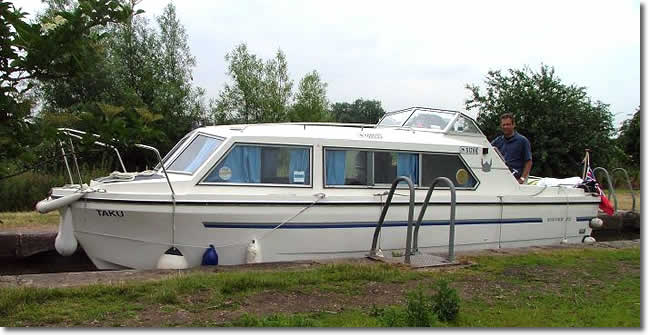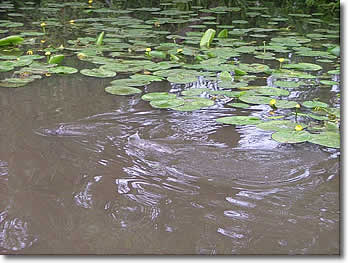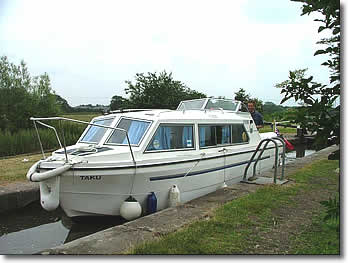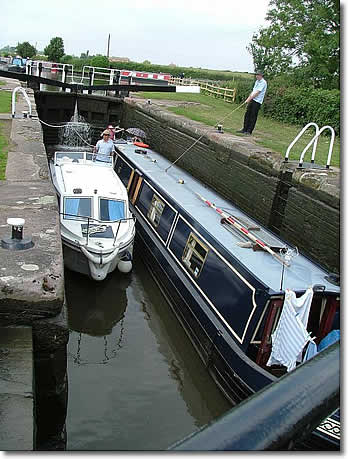This
year's holiday cruise for TAKU was a trip up the Shropshire Union
canal, 'The Shroppie'. We are moored at Sawley marina, which is about
60 miles from the start of the Shroppie, so we did not know how far
we would get, but set off aiming for Market Drayton.

The
first part of the cruise was along the Trent and Mersey canal to Fradley.
The first few locks are broad locks, changing to narrow locks at Burton-on-Trent.
The A38 with its heavy traffic is a fairly constant companion along
this route.
We stopped at Willington the first Sunday night: this is a small village
with all of the required boater facilities: small shops, 3 pubs and
a sanitary station. The railway line alongside the canal can surprise
you when you are woken at night by high-speed trains which seem to
charge straight through the cockpit.
We passed through Fradley on the Monday evening: it is always best
to go through this busy junction off-peak. The presence of long-term
moorings on the approaches to the locks in this flight seems crazy,
as it turns this junction into a nightmare for inexperienced hire
boaters, who cannot moor next to the locks and who do not have the
experience to hold their boats steady in the channel on the rudder,
especially as some of the long-term moorers run their props to load
their diesels.
On Tuesday we cruised up to Rugeley and shopped for food and petrol.
We were then assailed by the Taku's enemy on the narrow canals, WIND,
accompanied by showers. I was determined not to moor in Rugeley overnight,
so when there was an apparent break in the weather we set off towards
Great Haywood, but after a hairy crossing of the first aqueduct and
a near miss at the next bridge we found a hedge to moor against, and
spent the night next to a noisy flock of sheep, with the wind howling
over the boat.
| On Wednesday
we entered the Stafford and Worcester canal, and crossed beautiful
Tixall Wide lake,: this lake was created because the owner of
Tixall Hall would only allow construction of the canal across
the prospect from the Hall if the canal was made to look like
an ornamental lake. It has extensive lily-covered shallows, and
is home to many wildfowl including great crested grebes: see the
picture of where a grebe and her chick had been only half a moment
before! |
 |
When
we reached the Sow valley the wind was up to full force again, and
we baulked at crossing the aqueduct at Milford, so we moored under
the trees and watched other boats banging their way off the sides
as they attempted to cross. We helped to push two narrow boats across
after they became stuck against the concrete edge by the force of
the wind.
| The
following day we cruised through Penkridge and Gailey, and passed
through Autherley Junction and on to the Shropshire Union late
in the evening, mooring past Wolverhampton Boat Club, just before
the start of the famous 'Shroppie Shelf'. This shelf consists
of a rough ledge of concrete just below the waterline, often covered
by slabs, as in the picture. Boaters avoid mooring against it,
and many boats carry car wheels on their roof, so that these can
be floated on a leash when mooring, to keep the boat off the shelf.
We did see one hire boat defiantly moored tight into the bank,
but it was grounded on the shelf at an angle of 20 degrees! |
.jpg) |
We
moved up to the shelfless section between bridges 7 and 8 for breakfast
on Friday: this lower section of the Shroppie has both wide and narrow
sections, some almost as wide as Tixall Wide, and others as narrow
as a narrow lock, with the added excitement of the Shelf to watch
out for. We really did not know what to expect on the rest of the
canal. What we found is that because the canal runs like a Roman road,
straight for its destination, it consists of cuttings and embankments,
mainly cuttings it seems, and now that these are fully forested, the
effect is of a tunnel through the trees, with high bridges spanning
the cutting at ground level above. There were some quite magical effects
of light and shadow.
The
canal also crosses the A5 on the Stretton aqueduct: we had often seen
the aqueduct from the A5 and wondered what it would be like to see
the road from the aqueduct: the reality is surprisingly undramatic,
especially as the towering weeds provide a very different aspect from
the one depicted on the picture postcards of the aqueduct. (pics 21,22).
| We
reached our final mooring at Goldstone Wharf on Friday evening,
and decided against going up to Market Drayton through the Tyrley
flight of locks, giving ourselves the Saturday 'off' and playing
host to Lynne's parents, who visited us from their home near Mold
about an hour's drive away. (pic 036) |
.jpg) |
Our
cruise back went smoothly, with no high winds this time, and we were
joined on our last day, the second Thursday, by our son, who had just
finished his term at Leicester University, and who drove out to meet
us at Willington for the cruise back to Sawley.
Summary
12 days, 169 miles and 72 locks.
General Points
We did not encounter any 'dangerous drivers' on this trip, although
there was one impatient boater who amused us with his racing starts
from the bank in his narrowboat, sending up fountains of spray.
Many hireboat narrowboaters adopt a mooring strategy which consists
of somehow getting some part of the boat with a metre of the shore,
whereupon the crew, sometimes including the 'captain' all leap for
the shore with ropes and haul the boat in sideways by main force:
this left us speechless with laughter on several occasions.
Fenders
There has been some discussion of fenders on the site recently, so
this is our contribution: it 'works for us' as they say:
|
We were
able to travel through all of the locks and narrows with all
fenders down, and the broad locks were wide enough for us to
share the locks with narrowboats with fenders down.
We found
that the best setting of fenders in the narrow locks is to have
them trailing in the water, as the biggest danger is from the
low edges when going down the locks.

|
 |
We had some big and bouncy fenders around the bows, looped onto, or
kept in against the boat by, a rope strung from the forward fender
cleats and threaded through the bow mooring ring. These fenders protect
the bows on an angled approach to a lock, and the rope strung low
down prevents them from riding up over the low lock edges. It is best
not to have big and bouncy fenders on the sides of the boat as not
only do they get in the way, but the 'fender-bounce' from one side
of the lock to the other can be unpredictable and dangerous to the
boat.
With this setup the only minor scrapes that we picked up were just
below the rubbing-strip, and there is no easy way to prevent these
scrapes when there are brick and iron projections from all angles
in the old narrow locks.
I hope this is helpful.
Roger and Lynne Lainé









.jpg)
.jpg)
.jpg)
.jpg)
.jpg)
.jpg)
.jpg)
.jpg)
.jpg)

